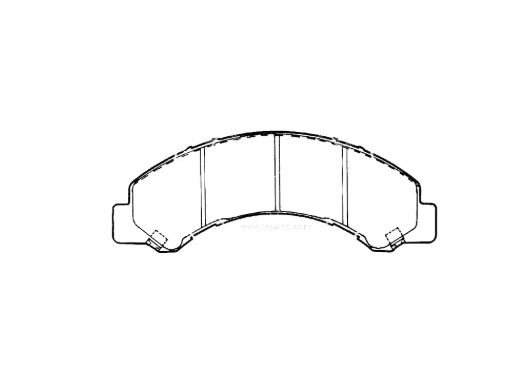Carbon Ceramic vs. Ceramic Brake Pads: Core Differences
Material Composition Explained
To really get what sets carbon ceramic apart from regular ceramic brake pads, we need to look at what goes into making them. Standard ceramic pads typically contain ceramic fibers mixed with non-ferrous materials and some sort of bonding agent. What makes them stand out is how well they stop vehicles while producing almost no dust on wheels. Carbon ceramic versions take things further by blending carbon materials into a ceramic base. This creates something that performs exceptionally well when pushed hard, especially during track days or heavy towing situations. The actual difference matters a lot for real world driving since it changes how effectively brakes work and how cars respond under pressure. Some drivers prefer one type over another depending on whether they want everyday reliability or track performance capabilities.
Heat Dissipation Capabilities
Heat dissipation works differently between ceramic and carbon ceramic brake pads. Ceramic versions handle heat pretty well for normal driving conditions, which is why they work great for daily commuting on city streets and highways. Carbon ceramic pads though? They're built to甩 off heat much better, which makes them popular among sports cars and race vehicles. Studies show these carbon ceramic brakes keep performing reliably even when things get really hot, so drivers don't experience that dreaded brake fade feeling when stopping hard or going down steep hills.
Weight and Rotor Compatibility
Brake pad weight and how they match up with rotors really matters when talking about how a car handles and stops effectively. Carbon ceramic pads tend to be much lighter than other options, something that makes cars perform better because there's less weight hanging around the wheels. But here's the catch these special pads need particular kinds of rotors if they're going to work properly over time. Regular ceramic pads on the other hand are bulkier and just fine with standard rotors most vehicles come with. Getting this matching right isn't just about making sure things fit during installation it actually changes how well the whole braking system works. Most mechanics will tell anyone who asks that picking the correct pad rotor combo saves money in the long run since it means fewer repairs down the road.
Performance Under Pressure
Stopping Power in Daily Driving
For people who drive around town every day, ceramic brake pads generally stop the car reliably enough, so they work pretty well for regular folks commuting back and forth. These pads give consistent braking response too, something that matters a lot when stopping and starting constantly in city traffic or merging onto highways. Carbon ceramic options might seem better for those really hard stops, but honestly most everyday drivers don't need them at all. The reason? Carbon ceramics perform much better when pushed to the limit, like during track days or heavy downhill braking. Most folks just want something that works day after day without hassle. That's why ceramic pads remain popular among average drivers looking for good stopping power without breaking the bank or dealing with excessive wear and tear on their vehicles.
High-Temperature Resistance and Brake Fade
Regular ceramic brake pads work fine under normal conditions but tend to lose effectiveness when they get too hot from prolonged stops. That's why most people find these pads work well enough for daily commuting around town, though they won't cut it on track days or aggressive mountain drives. Carbon ceramic pads tell a different story altogether. These bad boys keep performing strong even after repeated hard stops, so brake fade becomes almost non-existent. Mechanics who install brakes on race cars always point out how crucial this heat resistance really is. When pushing a car to its limits lap after lap, having predictable stopping power matters a lot. So if someone needs brake pads that don't give up when things heat up, carbon ceramics are definitely worth considering despite their higher price tag.
Noise and Dust Output Comparison
Most drivers know ceramic brake pads for being super quiet and producing almost no dust at all, making them a big plus for anyone who wants to enjoy their drive without constant complaints from passengers about noise. Cleaner wheels are another bonus, so nobody has to spend extra time scrubbing grime off spokes after every trip. Now, carbon ceramic pads aren't bad either when it comes to noise control, but let's face it – push these hard on performance roads or track days and watch what happens. They start throwing out more heat and dust than regular ceramics, which means mechanics will be busy cleaning things up sooner rather than later. People who actually drive their cars day to day tend to prefer ceramic pads because they just don't make that annoying scraping sound other materials do. If keeping maintenance costs down matters more than showing off fancy specs, then ceramic remains king for most folks who simply want to get from point A to B without drama.
Durability and Longevity
Lifespan of Ceramic vs. Carbon Ceramic
Looking at how long ceramic versus carbon ceramic brake pads last reveals some pretty clear differences. Ceramic pads generally hold up well during normal driving situations. Most drivers find they don't wear down much over time and keep working consistently day after day, making them great for people who just drive to work and back. But when things get serious on the track or during aggressive driving, carbon ceramic pads really show their stuff. These specialized components can handle the intense heat and stress of racing conditions without falling apart. Industry data suggests while they may require particular care sometimes, carbon ceramic versions actually last longer in these tough situations compared to regular ceramic pads, which tends to be why professional racers prefer them for competition.
Impact of Driving Habits on Wear
The way people drive really affects how long ceramic and carbon ceramic brake pads last. When someone drives aggressively with lots of hard stops and constant fast starts, this wears down brake pads much faster than normal driving conditions would allow. Most drivers don't realize just how much their daily habits impact brake pad life. For instance, city drivers who stop frequently at traffic lights experience different wear patterns compared to highway commuters. Knowing these differences lets car owners pick brake pads that match what they actually need based on their regular driving patterns. Over time, this kind of awareness leads to better performing brakes and longer service intervals between replacements, which means safer driving experiences overall without sacrificing stopping power when needed most.
Cost and Maintenance Factors
Initial Investment and Replacement Costs
Looking at what people actually pay out of pocket, ceramic brake pads usually come in cheaper than their carbon ceramic counterparts both when buying new or replacing old ones. The upfront price tag for ceramic is significantly lower, making these pads a go to choice for regular drivers watching their wallets. Carbon ceramic pads definitely cost more money right from the start. But here's the thing about carbon ceramics though they hit consumers harder initially, these pads often save money over time because they last longer and perform better, especially on sports cars and performance oriented vehicles. Some actual testing shows that while the sticker shock might be bigger, the total cost of owning a car with carbon ceramic brakes ends up being lower in situations where stopping power matters most and parts need to stand up to repeated heavy use.
Maintenance Requirements for Each Type
Keeping ceramic and carbon ceramic brake pads running at their best really depends on regular maintenance. Ceramic pads generally don't need much attention beyond checking them from time to time and replacing when necessary. These pads create far less brake dust compared to other types and tend to last longer under normal driving conditions, so most people find them pretty straightforward to maintain. Carbon ceramic pads tell a different story though. These bad boys often need special handling that comes with a bigger price tag over time. Drivers will probably end up inspecting them more regularly and replacing components sooner because the extreme friction they generate can actually wear down rotors faster, especially during aggressive driving or track days. Getting familiar with what each type needs before buying makes all the difference in budget planning and prevents those nasty surprise repair bills down the road.
Which Brake Pad Is Right for You?
Best Applications for Ceramic Brake Pads
For regular driving around town, ceramic brake pads work pretty well most of the time. They strike a decent balance between stopping power and ride comfort that's good enough for normal roads and highways. Family sedans, daily commuters, and small pickup trucks tend to benefit from these pads since they don't make as much noise or leave behind all that brake dust on wheels. Mechanics will usually suggest going with ceramic options when someone wants something reliable without breaking the bank. The price is reasonable compared to other types, and they get the job done fine unless someone regularly drives through mountain passes or does serious track days.
When to Opt for Carbon Ceramic Brakes
Drivers who push their machines to the limit on race tracks or during spirited drives need something better than regular brakes, and carbon ceramic options fit the bill. These special brake pads work wonders in sports cars and track-ready machines because they handle extreme heat much better than standard materials. Sure, carbon ceramics come with a hefty price tag, but when driving conditions get intense, most serious enthusiasts find the extra cost justified. What sets these brakes apart is how they stay cool even after repeated hard stops, delivering reliable stopping power lap after lap. That's why so many racing pros and weekend warriors swear by them when every second counts and performance matters most.
FAQs
What are ceramic brake pads made of? Ceramic brake pads are composed mainly of ceramic fibers, non-ferrous materials, and bonding agents.
Why are carbon ceramic brake pads favored for high-performance vehicles? Carbon ceramic pads excel in dissipating heat and maintain performance at elevated temperatures, reducing brake fade in intense conditions.
Do driving habits affect brake pad wear? Yes, aggressive driving with heavy braking can accelerate wear, shortening the lifespan of brake pads.
How does the cost compare between ceramic and carbon ceramic brake pads? Ceramic pads are generally more budget-friendly, while carbon ceramic pads require a higher initial investment but offer long-term savings.
What maintenance do carbon ceramic brake pads require? Carbon ceramic pads often require more frequent inspections and potential replacements, especially in high-performance scenarios.

